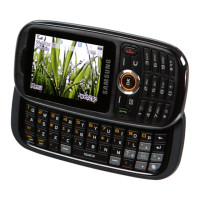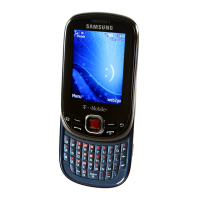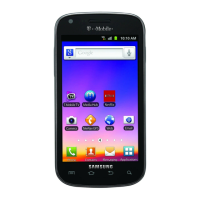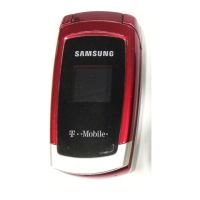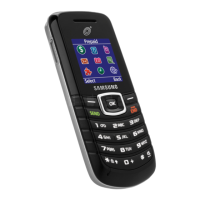Do you have a question about the Samsung SGH T319 and is the answer not in the manual?
Steps to activate a cellular network phone by installing a SIM card.
Instructions for handling and inserting the SIM card into the phone.
Information on charging the phone's Li-ion battery using a travel adapter.
Explains the warning tone and display message when the battery is low.
Step-by-step guide to power the phone on and off, including password/PIN entry.
Instructions for new users to set up voicemail, including password and greeting.
Steps to access voicemail via menu or direct key press.
Procedure to change the default voice mail service number.
Outlines key features like user-friendly access, IM, and multimedia capabilities.
Illustrates and labels the main physical elements of the phone.
Lists and describes the function of each key on the phone.
Explains the display areas, icons, and their meanings.
Details backlight settings and information shown on the external display.
Explains how to access help files and information via t-zones.
Instructions on how to dial numbers, including international calls and number correction.
How to recall numbers from call records and make calls from the phonebook.
How to adjust earpiece and ring volume using the volume keys.
Instructions on how to answer or reject incoming calls.
How to view call logs, delete records, and check call time.
How to activate silent mode and understanding the roles of soft keys.
Navigating menus, putting calls on hold, and managing calls during a call.
How to make multi-party calls, have private conversations, and drop participants.
How to tailor phone functions using menus and sub-menus via scrolling or shortcuts.
A structured list showing the phone's menu hierarchy and option numbers.
Explains different text input modes (ABC, T9, Number, Symbol) and indicators.
Guide to using T9 predictive text for efficient word entry.
Instructions for typing text by pressing keys multiple times for each letter.
Shows character mapping for each number key in ABC and T9 modes.
How to insert symbols and enter numbers while typing.
Steps to save contacts with name and type to the phone's memory.
How to search for, view, and dial stored contacts.
Steps to save contacts to the SIM card memory.
How to set up and use speed dial entries for quick calling.
Copying SIM entries, deleting all entries, and group settings.
How to view service numbers provided by the service provider.
Lists available message types: Voice Notes, Text, Picture, Browser, Voice Mail, Broadcast.
How to record and send a voice message.
Sending SMS/EMS, creating messages, and managing the inbox.
Managing sent messages and using the MMS service.
Steps to create and send a multimedia (picture) message.
How to manage web messages and access voicemail.
Configuring message settings and starting Instant Messaging.
How to change the current time and date, set time format, and auto-update.
How to select display language and set a custom greeting message.
Options for auto-redial, answer modes, and display customization.
How to set wallpaper, adjust brightness, contrast, and backlight.
How to customize various sound settings like ringtones and volumes.
Setting up call forwarding and managing call waiting.
How to select networks when roaming and manage caller ID.
How to restrict phone use via PIN, password, privacy, and FDN mode.
Checking memory usage and resetting phone settings to default.
Accessing the Wireless Web and managing sounds and images.
Options for downloaded sounds, recorded voice notes, and stored images.
Downloading, launching, and viewing information about games.
Setting alarms, managing the calendar, and writing memos.
Using the phone as a calculator, managing to-do lists, and using timer/stopwatch.
How to use the camera module and capture photos.
Explains camera modes, photo album options, and managing photos.
How to delete photos and view images stored on the t-zone website.
Setting image parameters and checking memory usage for camera files.
Explains the WAP browser and accessing the Wireless Web.
How to scroll, select items, and enter text within the browser.
Lists browser functions and how to store and access URL addresses.
Information on RF energy exposure, FCC limits, and SAR compliance.
Safety instructions for the travel adapter.
FDA information on RF exposure, health effects, and research.
Safety precautions in specific environments and near medical devices.
Information on phone compatibility with hearing aids and ratings.
How to make emergency calls and general safety warnings.
Advice on handling, charging, and caring for the battery and phone.
Details what is covered by the warranty and for how long.
Lists conditions and damages not covered by the limited warranty.
Explains SAMSUNG's responsibilities for repair/replacement and service procedures.
Steps to activate a cellular network phone by installing a SIM card.
Instructions for handling and inserting the SIM card into the phone.
Information on charging the phone's Li-ion battery using a travel adapter.
Explains the warning tone and display message when the battery is low.
Step-by-step guide to power the phone on and off, including password/PIN entry.
Instructions for new users to set up voicemail, including password and greeting.
Steps to access voicemail via menu or direct key press.
Procedure to change the default voice mail service number.
Outlines key features like user-friendly access, IM, and multimedia capabilities.
Illustrates and labels the main physical elements of the phone.
Lists and describes the function of each key on the phone.
Explains the display areas, icons, and their meanings.
Details backlight settings and information shown on the external display.
Explains how to access help files and information via t-zones.
Instructions on how to dial numbers, including international calls and number correction.
How to recall numbers from call records and make calls from the phonebook.
How to adjust earpiece and ring volume using the volume keys.
Instructions on how to answer or reject incoming calls.
How to view call logs, delete records, and check call time.
How to activate silent mode and understanding the roles of soft keys.
Navigating menus, putting calls on hold, and managing calls during a call.
How to make multi-party calls, have private conversations, and drop participants.
How to tailor phone functions using menus and sub-menus via scrolling or shortcuts.
A structured list showing the phone's menu hierarchy and option numbers.
Explains different text input modes (ABC, T9, Number, Symbol) and indicators.
Guide to using T9 predictive text for efficient word entry.
Instructions for typing text by pressing keys multiple times for each letter.
Shows character mapping for each number key in ABC and T9 modes.
How to insert symbols and enter numbers while typing.
Steps to save contacts with name and type to the phone's memory.
How to search for, view, and dial stored contacts.
Steps to save contacts to the SIM card memory.
How to set up and use speed dial entries for quick calling.
Copying SIM entries, deleting all entries, and group settings.
How to view service numbers provided by the service provider.
Lists available message types: Voice Notes, Text, Picture, Browser, Voice Mail, Broadcast.
How to record and send a voice message.
Sending SMS/EMS, creating messages, and managing the inbox.
Managing sent messages and using the MMS service.
Steps to create and send a multimedia (picture) message.
How to manage web messages and access voicemail.
Configuring message settings and starting Instant Messaging.
How to change the current time and date, set time format, and auto-update.
How to select display language and set a custom greeting message.
Options for auto-redial, answer modes, and display customization.
How to set wallpaper, adjust brightness, contrast, and backlight.
How to customize various sound settings like ringtones and volumes.
Setting up call forwarding and managing call waiting.
How to select networks when roaming and manage caller ID.
How to restrict phone use via PIN, password, privacy, and FDN mode.
Checking memory usage and resetting phone settings to default.
Accessing the Wireless Web and managing sounds and images.
Options for downloaded sounds, recorded voice notes, and stored images.
Downloading, launching, and viewing information about games.
Setting alarms, managing the calendar, and writing memos.
Using the phone as a calculator, managing to-do lists, and using timer/stopwatch.
How to use the camera module and capture photos.
Explains camera modes, photo album options, and managing photos.
How to delete photos and view images stored on the t-zone website.
Setting image parameters and checking memory usage for camera files.
Explains the WAP browser and accessing the Wireless Web.
How to scroll, select items, and enter text within the browser.
Lists browser functions and how to store and access URL addresses.
Information on RF energy exposure, FCC limits, and SAR compliance.
Safety instructions for the travel adapter.
FDA information on RF exposure, health effects, and research.
Safety precautions in specific environments and near medical devices.
Information on phone compatibility with hearing aids and ratings.
How to make emergency calls and general safety warnings.
Advice on handling, charging, and caring for the battery and phone.
Details what is covered by the warranty and for how long.
Lists conditions and damages not covered by the limited warranty.
Explains SAMSUNG's responsibilities for repair/replacement and service procedures.
| Brand | Samsung |
|---|---|
| Model | SGH T319 |
| Category | Cell Phone |
| Language | English |
